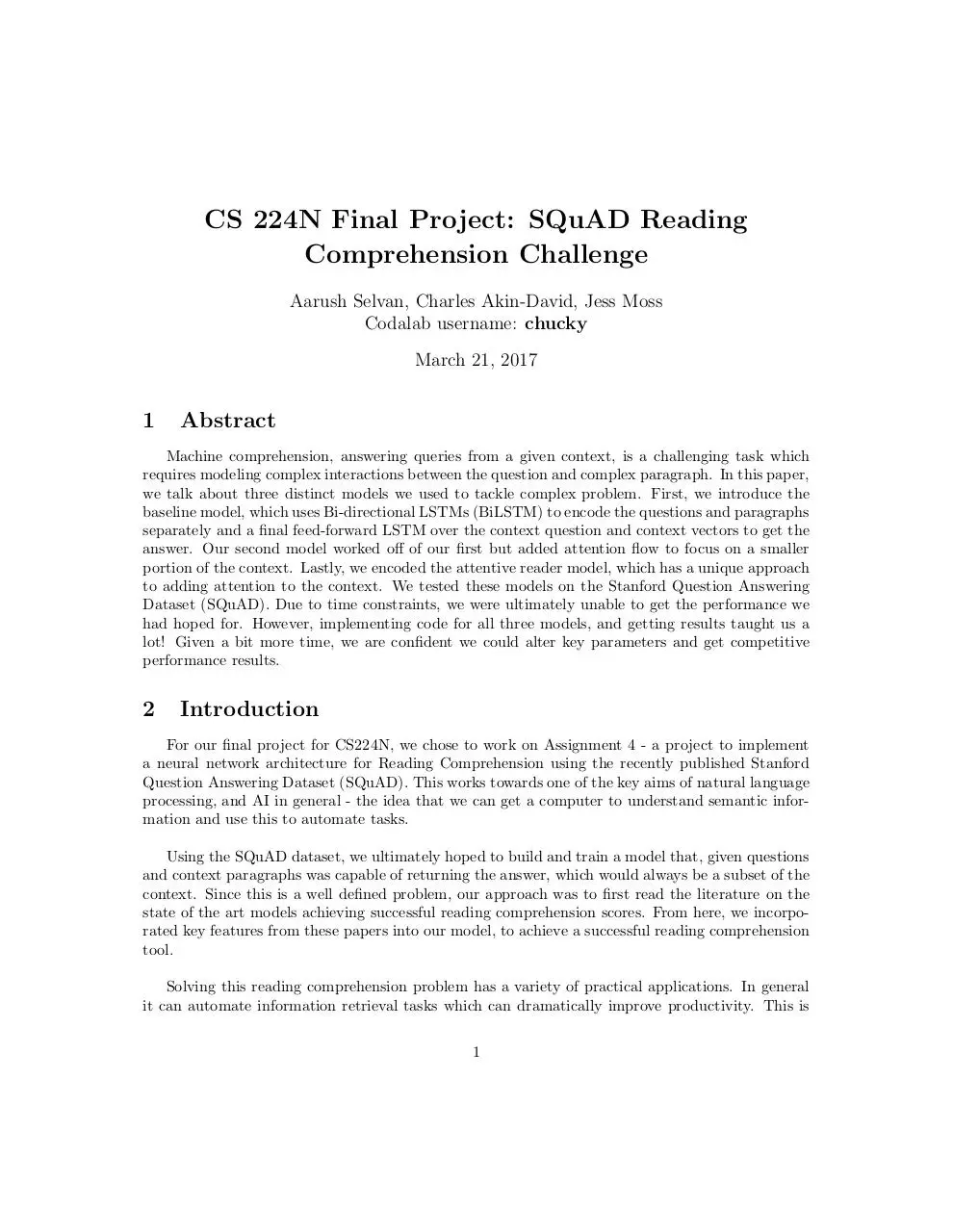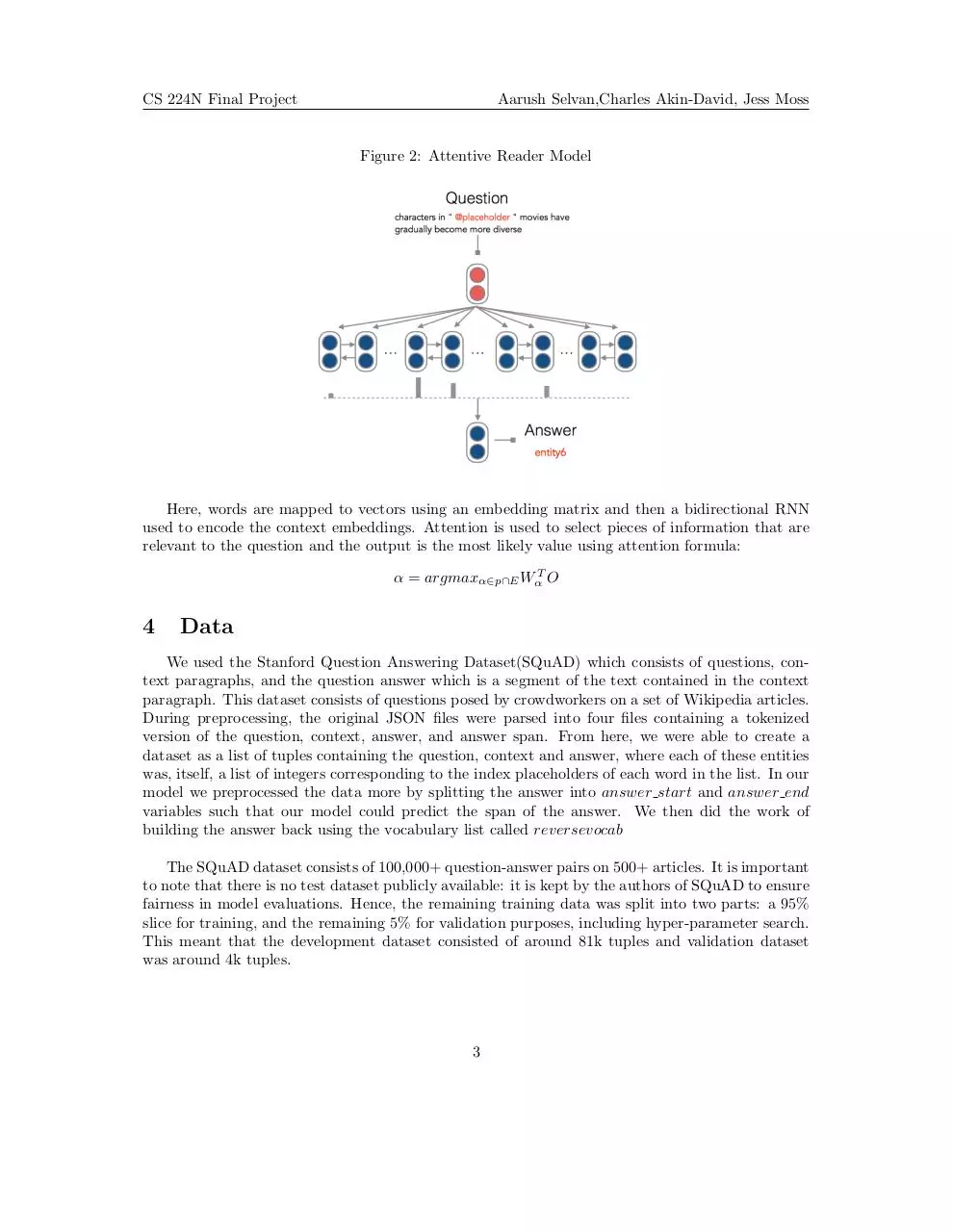textbf CS 224N Final Project SQuAD Reading Comprehension Challenge (PDF)
File information
This PDF 1.5 document has been generated by TeX / pdfTeX-1.40.17, and has been sent on pdf-archive.com on 29/04/2020 at 04:16, from IP address 67.142.x.x.
The current document download page has been viewed 289 times.
File size: 1.15 MB (7 pages).
Privacy: public file





File preview
CS 224N Final Project: SQuAD Reading
Comprehension Challenge
Aarush Selvan, Charles Akin-David, Jess Moss
Codalab username: chucky
March 21, 2017
1
Abstract
Machine comprehension, answering queries from a given context, is a challenging task which
requires modeling complex interactions between the question and complex paragraph. In this paper,
we talk about three distinct models we used to tackle complex problem. First, we introduce the
baseline model, which uses Bi-directional LSTMs (BiLSTM) to encode the questions and paragraphs
separately and a final feed-forward LSTM over the context question and context vectors to get the
answer. Our second model worked off of our first but added attention flow to focus on a smaller
portion of the context. Lastly, we encoded the attentive reader model, which has a unique approach
to adding attention to the context. We tested these models on the Stanford Question Answering
Dataset (SQuAD). Due to time constraints, we were ultimately unable to get the performance we
had hoped for. However, implementing code for all three models, and getting results taught us a
lot! Given a bit more time, we are confident we could alter key parameters and get competitive
performance results.
2
Introduction
For our final project for CS224N, we chose to work on Assignment 4 - a project to implement
a neural network architecture for Reading Comprehension using the recently published Stanford
Question Answering Dataset (SQuAD). This works towards one of the key aims of natural language
processing, and AI in general - the idea that we can get a computer to understand semantic information and use this to automate tasks.
Using the SQuAD dataset, we ultimately hoped to build and train a model that, given questions
and context paragraphs was capable of returning the answer, which would always be a subset of the
context. Since this is a well defined problem, our approach was to first read the literature on the
state of the art models achieving successful reading comprehension scores. From here, we incorporated key features from these papers into our model, to achieve a successful reading comprehension
tool.
Solving this reading comprehension problem has a variety of practical applications. In general
it can automate information retrieval tasks which can dramatically improve productivity. This is
1
CS 224N Final Project
Aarush Selvan,Charles Akin-David, Jess Moss
because people can spend less time searching for answers to specific questions and more time solving
new problems. For instance, one can imagine this tool being used to automate paralegal services, by
scanning case documents to find specific answers to questions, allowing lawyers to spend more time
on legal strategy rather looking things up. Alternatively, it could be used in a more straightforward
fashion to help students lookup homework answers from Wikipedia!
3
Background/Related Work
We gained inspiration from several papers which ran successful reading comprehension models
on SQuAD or similar datasets.
The first paper we studied was titled ”Multi-Perspective Context Matching for Machine Comprehension”. While this model employed certain more complex algorithms, it also created a starting
point for how a baseline model could look. Specifically, this model ran a bi-directional LSTM over
both the question and the context paragraph. For each point in the passage, the model matched
the context of this point against the encoded question and produced a matching vector. Lastly,
it employed a final bi-directional LSTM to aggregate all the information and predict the question
beginning and ending indexes.
Figure 1: Architecture for Multi-Perspective Context Matching Model.
The second paper we drew from was titled ”Bi-Directional Attention Flow For Machine Comprehension”. Attention methods have been used to focus on certain words in the context paragraph
based off complex interactions between the question and context paragraph. This model achieves
this by introducing a Bi-Directional Attentional Flow network, which represents the contexts at
different levels of granularity and ultimately obtains a query-aware context representation.
In ”A Thorough Examination of the CNN/Daily Mail Reading Comprehension Task” by Chen,
Bolton and Manning, they built an end-to-end neural network based on the Attentive Reader model
proposed by (Hermann et al., 2015).
2
CS 224N Final Project
Aarush Selvan,Charles Akin-David, Jess Moss
Figure 2: Attentive Reader Model
Here, words are mapped to vectors using an embedding matrix and then a bidirectional RNN
used to encode the context embeddings. Attention is used to select pieces of information that are
relevant to the question and the output is the most likely value using attention formula:
α = argmaxα∈p∩E WαT O
4
Data
We used the Stanford Question Answering Dataset(SQuAD) which consists of questions, context paragraphs, and the question answer which is a segment of the text contained in the context
paragraph. This dataset consists of questions posed by crowdworkers on a set of Wikipedia articles.
During preprocessing, the original JSON files were parsed into four files containing a tokenized
version of the question, context, answer, and answer span. From here, we were able to create a
dataset as a list of tuples containing the question, context and answer, where each of these entities
was, itself, a list of integers corresponding to the index placeholders of each word in the list. In our
model we preprocessed the data more by splitting the answer into answer start and answer end
variables such that our model could predict the span of the answer. We then did the work of
building the answer back using the vocabulary list called reversevocab
The SQuAD dataset consists of 100,000+ question-answer pairs on 500+ articles. It is important
to note that there is no test dataset publicly available: it is kept by the authors of SQuAD to ensure
fairness in model evaluations. Hence, the remaining training data was split into two parts: a 95%
slice for training, and the remaining 5% for validation purposes, including hyper-parameter search.
This meant that the development dataset consisted of around 81k tuples and validation dataset
was around 4k tuples.
3
CS 224N Final Project
5
Aarush Selvan,Charles Akin-David, Jess Moss
Approach
We began our approach by creating a baseline model. To create this, we ran a BiLSTM on the
question, and concatenated the two hidden outputs from the forward state and backwards state.
We than ran a BiLSTM over the context paragraph using the last hidden state from the question
representation we found in the previous step. Both of the BiLSTMs were run in our encode function with the question and context embeddings used as inputs. Lastly, in our decoder, we ran a
feed-forward LSTM over the context and question vectors, which we classified using softmax to get
the answer start and end. This approach gave us a F1 score of 3% on the validation set, which we
were not satisfied with.
Figure 3: Bi-directional LSTM model.
From here, we decided to add attention to our existing model. We hoped that attention would
allow us to focus on specific words in the context paragraph and increase our F1 score. We did
this by first running our original encode function mentioned above on the question. We then computed the attention vector over the context paragraph using the question outputs from the encode
function. Lastly, we computed new context representations by multiplying context with Attention.
Running this resulted in a F1 score of 5% on the validation set, which was a slight improvement,
but still did not provide the types of results we were hoping for.
Due to the lack of solid results on the validation set from the previous two approaches, we
decided to try the attentive reader model.
The attentive reader model had a different approach to adding attention to the context paragraph. We choose to use a GRU instead of an LSTM, as suggested in Chen et al’s paper. We ran
a GRU over the question and stored the last hidden state. We then ran a GRU over the context
and stored its outputs. Both of the GRUs were run in our encode function with the question and
4
CS 224N Final Project
Aarush Selvan,Charles Akin-David, Jess Moss
Figure 4: Attentive Reader Model.
context embeddings used as inputs. We then used our neural network to predict the answer start
and the answer end span. We did this by doing a dot product between the last hidden state of the
question and the outputs of the context. This resulted in a probability distribution matrix over
the context. We then used this matrix as our predictions to compute our loss. We masked the
context values that were padded in order to ensure that we were computing loss only over words
that appeared in the original context paragraph. The answer start and answer end values were
computed by taking argmax attention vector over the context output matrix. Softmax was used to
calculate loss.
Eg.
output, q = GRU(question)
X, hidden-state = GRU(context)
attention = softmax(X*q)
prediction = X*attention
We noticed that our gradients were exploding in the beginning of training and also that our
model was still doing poorly on the validation set, so we implemented gradient clipping in a similar
fashion to assignment 3. This allowed our model to learn without overfitting too strongly to the
development set. This also helped improve the scores we were getting on our validation set. We
ended up getting a F1 score of 10% with this model.
6
Experiments
In order to quantify our results, we compared the answers our model pulled from the context
paragraph to the ground true answers given by the SQuAD dataset. We then measured the F1 and
EM scores. Here, the F1 score was computed by treating the prediction and ground truth as bags
of tokens, and computing their F1. We took the maximum F1 over all of the ground truth answers
for a given question, and then averaged over all of the questions. The Exact Match(EM) measured
5
CS 224N Final Project
Aarush Selvan,Charles Akin-David, Jess Moss
(a) Dev Data
(b) Validation Data
Figure 5: F1 and EM Scores for our Dev and Validation Data
the percentage of predictions that match one of the ground truth answers exactly.
In order to get these scores, we also had to format our predictions by removing extra white
space between letters and punctuation marks. In doing so, we hoped to increases our EM score by
normalizing the text we received from the context IDs after joining the answer span together.
Figure 5 depicts the results from the Attentive Reader Model. As shown, this did well on the
dev set reaching 60% F1 and 32% EM, however performed poorly on validation set reaching about
10% F1 and 5% EM. Due to time constraints, these scores were calculated using a subset of about
1/10th of the data, and hence, we can see fairly extreme overfitting, however our model is also
learning.
7
Conclusion
Unfortunately, we were unable to achieve the types of results we desired. While, for the attentive
reader model, we were able to achieve our benchmark score of 60% on the development set, we were
only able to achieve a F1 score of around 3% on the validation data. This implies we still might be
overfitting to the development dataset. The highest EM and F1 score we were able to achieve on
validation dataset was 10% and 3% respectively.
We also noticed that the scores were even lower when submitted to the SQuAD leader-board.
This may be from implementation errors in our evaluate answer section. We noticed that the answers being returned were mostly one word answers. This can still lead to high scores in F1 but
will likely lead to poor EM scores since one word responses won’t match multi-word answers. We
ended up with about 3% F1 and 1% EM on the hidden SQuAD test dataset. This was very discouraging since we implemented three different models. Though our models were mostly baseline,
we had expected to at least break 10% on both F1 and EM for the SQuAD test dataset. Chen et
al.’s Attentive Reader model also used a bilinear term, which allowed the model to find similarities
6
CS 224N Final Project
Aarush Selvan,Charles Akin-David, Jess Moss
between the question and a word in the context with more flexibility than just a dot product. We
could have tried to improve the learning in our attentive reader model by implementing bilinear
attention or using concatenation followed by a small feed-forward network as suggested by Richard.
For future work, we plan to reevaluate our use of attention to ensure we are not overfitting
so heavily to the development set. We would add more complex attention functions to add more
plasticity to the way our model finds similarities between the question and the words in the context
paragraph. In addition, we would introduce dropout regularization during model training. This
would involve randomly dropping neurons at the forward pass during training. This prevents
the model from overfitting by preventing overly-complex adaptations on the training data, forcing
the model to learn redundancies. During test time, the dropout function is removed, and the
model should perform better because it will have learned the rules for solving the problem without
being too specific to the train dataset that it has seen over numerous epochs. Lastly, we faced
many difficulties getting our first model up due to challenges with the starter code. Though vanilla
Tensorflow gives a lot of freedom for customization, it is difficult to use when implementing a simple
baseline neural network. In the future, we would try and use some easy to work with Tensorflow
libraries such as TFLearn and Keras. This would allow us to at least get a baseline model quickly
that we could iterate off of. Then we would able to focus our efforts on hyperparameter tuning and
complex attention functions that we could either implement using the libraries or revert back to
Tensorflow once we had a solid grip of the model.
8
References
Chen, Danqi, Jason Bolton, and Christopher D. Manning. ”A thorough examination of the
cnn/daily mail reading comprehension task.” arXiv preprint arXiv:1606.02858 (2016).
Hermann, Karl Moritz, Tomáš Kočiský, et al. ”Teaching Machines to Read and Comprehend.”
arXiv preprint arXiv:1506.03340 (2015).
Seo, Minjoon, et al. ”Bidirectional Attention Flow for Machine Comprehension.” arXiv preprint
arXiv:1611.01603 (2016).
Wang, Zhiguo, et al. ”Multi-Perspective Context Matching for Machine Comprehension.” arXiv
preprint arXiv:1612.04211 (2016).
9
Supplementary Material
See attached Zip file with source code.
10
Contributions
All group members made significant contributions to the project, enjoyed working with each
other and enjoyed this class!
7
Download textbf CS 224N Final Project SQuAD Reading Comprehension Challenge
textbf_CS_224N_Final_Project__SQuAD_Reading_Comprehension_Challenge.pdf (PDF, 1.15 MB)
Download PDF
Share this file on social networks
Link to this page
Permanent link
Use the permanent link to the download page to share your document on Facebook, Twitter, LinkedIn, or directly with a contact by e-Mail, Messenger, Whatsapp, Line..
Short link
Use the short link to share your document on Twitter or by text message (SMS)
HTML Code
Copy the following HTML code to share your document on a Website or Blog
QR Code to this page

This file has been shared publicly by a user of PDF Archive.
Document ID: 0001938124.